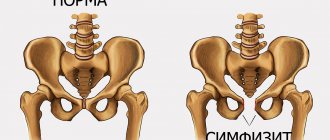The eighth month of pregnancy is a difficult period. The baby has finished forming its body and is constantly making itself felt with kicks and movements. A woman, tired over the previous seven months, wants to give birth as soon as possible and it seems that this will happen any day now. However, it will still be a long time before the mother sees the child. During this period, you need to be patient, calmly wait and prepare.
Feel
At 32-33 weeks of gestation, the uterus enlarges significantly. It puts pressure on surrounding organs. First of all, the pressure falls on the bladder, and therefore the process of urination becomes more frequent.
If before the third trimester there were no problems with bowel movements, they will certainly appear at this time.
Difficulty with bowel movements should be eliminated with the help of rectal suppositories or microenema devices, but with the permission of a doctor.
At the beginning of the 35th week, the pregnant woman’s weight increases from 8 to 10 kg. Sometimes it is at this time that excess weight gain appears.
A sharp gain in kilograms does not lead to a failure in the diet, but to complications of pregnancy or intrauterine pathologies of the fetus.
Primary training contractions appear. The muscle layer continues to stretch, followed by the joints.
The uterus puts pressure on the inguinal ligaments, which leads to disruption of natural gait and minor pain.
There is constant heaviness in the legs and swelling. Problems with the condition of the veins develop, so it is necessary to constantly wear compression garments.
No matter how much expectant mothers would like to look their best, increased pigmentation in combination with excess body weight is not masked, hence the development of a psychological barrier.
Some pregnant women are overcome by a feeling of fear and anxiety about the upcoming birth.
Eighth month of pregnancy
The middle of the last, third, trimester is the preparatory stage before childbirth. The first difficult months are forgotten, the child is already formed, and is now simply growing and waiting to be born. By this period, a woman begins to feel some moral and physical fatigue, she wants to meet the baby quickly. But don't rush.
Of course, the eighth month is not the most pleasant. Shortness of breath, heartburn, back pain, and trips to the toilet became more frequent. Swelling has increased, problems with sleep, and long walks. And all this thanks to the reached size of the uterus and fetus, which are still in the stage of intensive growth.
Don't be alarmed by worsening symptoms. This is natural and is associated only with the approach of the cherished date. But you shouldn’t remain completely indifferent to them. If your blood pressure “jumps,” your discharge becomes questionable, you experience constant nosebleeds, or other serious suspicions arise, consult a doctor.
Perhaps only at this stage will the expectant mother begin to worry about Braxton Hicks training contractions. Watch them. Such uterine contractions are characterized by painlessness, irregularity and rapid patency. As soon as you notice discomfort associated with spasms, or a dull pain radiating to the lower back, as well as a periodicity of an hour or two, call an ambulance and go to the maternity hospital. This is how labor can begin.
Emotionally, a woman feels exhaustion, anxiety about the future, some depression, absent-mindedness, and a change in mood. Right now I want to cry. You shouldn’t become limp, this is temporary and absolutely within the norm. It’s better, while you still have a few weeks, arrange a place for the future little resident and, just in case, pack the necessary things for the maternity hospital.
How the fetus behaves and develops
From the 32nd week of pregnancy, the child leads an active lifestyle. Often he pushes mom in the most unexpected places, such as the ribs. His movements are conscious, he can respond to touches on his stomach, and senses his mother’s mood.
Character is formed - by how the child behaves in the womb, one can predict whether the baby will be calm or overly active.
By the end of 35-36 weeks, the baby’s weight is 2500-2900 g, with a height of 45 to 58 cm. It becomes cramped in the uterus, which is why, stretching out its arms or legs, the fetus causes some painful discomfort to the mother.
The endocrine system is actively working, the cerebral cortex is improving. Interestingly, the formation of convolutions continues until the birth of the child.
The baby follows “his own routine”; his periods of sleep and wakefulness are clearly defined. In most cases, he is in a state of sleep, and sometimes the lack of movement frightens his mother. But an excessive number of movements should alert her to the possibility of being in a threatening state.
The baby is gaining weight, and the accumulation of subcutaneous fat is increasing. The fluff covering the body is gradually replaced by lubricant for easy passage through the birth canal.
The respiratory system is formed, a special lubricant or surfactant does not allow the alveoli to stick together, which is extremely necessary for the normal functioning of the baby.
How to deal with insomnia and feeling tired
There are many reasons for insomnia during pregnancy: hormonal changes, uncomfortable posture, discomfort due to a large belly, leg cramps, activity of the baby, and strange dreams.
Like many other phenomena, insomnia is a frequent companion to pregnancy: it occurs in almost 80% of expectant mothers.
How to overcome insomnia? Follow simple rules that will help you normalize your sleep.
- Find a comfortable sleeping position. Doctors recommend sleeping on your left side (this is better for blood circulation). Pillows and a hard mattress will help you get comfortable.
- Get ready for bed by taking a warm bath.
- Change the decor in the bedroom - perhaps it is not conducive to sleep enough: bright colors of the interior, light and noise from the street.
- Ventilate the room more often, turn down the heating.
- Try aromatherapy. Scents such as lavender, lemon balm, geranium, chamomile are good for calming the nervous system.
- Use relaxation techniques, meditate, listen to calm, soothing music before bed.
- Be physically active during the day, play sports, do gymnastics for pregnant women.
- If you have the opportunity to take a short nap during the day, don't miss it. But remember that long naps during the day will only make the problem worse.
- If you've tried everything and can't sleep, get up. Read your favorite book, drink a glass of warm milk, eat a cracker.
Reminding yourself that pregnancy does not last forever, that most other women are going through the same condition and experiencing the same emotions, will give you strength and patience.
Changes in a woman's body
Many mothers note the following “eight-month symptoms”:
- increased heartburn;
- nasal congestion;
- change in gait;
- insomnia;
- heaviness in the legs;
- fatigue from one’s own “interesting” situation.
There is a change in the nature of the discharge, which should be treated with care and caution.
Normally, vaginal discharge has a thick consistency with a whitish tint. The appearance of watery or curdled discharge, or a change in color (greenish, brown or scarlet), indicates serious problems and poses a potential threat to the life and health of the baby.
Training contractions may bother a first-time mother, but they do not pose any danger. They are necessary for training the muscles of the vagina and uterus.
Changes in the female body due to pregnancy affect the following organs and systems:
- Circulatory system: blood exchange increases, the placenta is nourished, oxygen is distributed.
- Respiratory system: the process of inhalation and exhalation becomes more complicated, shortness of breath appears.
- The breasts become enlarged, the aureole darkens, and sometimes a stretchy viscous substance appears—primary colostrum.
- Pigmentation intensifies.
- The pelvic bones gradually diverge and become visible to the eye.
- A round, high belly “prevents” you from performing normal actions: putting on shoes, zipping up, bending over.
In the eighth obstetric month, a pregnant woman may experience nausea and vomiting.
This is due to indigestion or increased symptoms of heartburn. Toxicosis at the 8th month of gestation carries a threat of developing preeclampsia. Blood pressure rises, proteinuria appears.
Adverse gestational symptoms should be monitored by a physician.
What remains to be done
It would be better if the child waited a little longer before coming into the world. The development of the body is not over; several important things need to be done and what has already been done is completed.
- The fetal brain is improved, protective myelin sheaths of nerve fibers are formed, and connections between cells are established.
- The liver is actively working, accumulating iron, which after birth will be used in hematopoiesis processes.
- Active growth and weight gain continues. The weight of a child at the 8th month of pregnancy reaches 2.5 kg, and another 15-30 g are added every day. There is almost no space left in the uterus, the movements of the embryo are difficult, but more intense than before.
- A layer of lubricant thickens, which will allow the fetus to more easily overcome the birth canal.
- The normal operating mode of the thermoregulation system is established, and the bright pink color of the skin disappears.
- The muscles that provide sucking movements are fully formed.
Analyzes and research
A weekly visit to the gynecologist allows you to timely identify possible abnormalities in the health and development of the fetus.
Required research includes:
- external examination: weight, detection of edema, height of the uterine fundus;
- study of test results: TAM, UAC, blood glucose, coagulogram;
- Fetal CTG and ultrasound to assess the degree of maturity of the placenta, fetal lungs and estimated height and weight, as well as to determine the condition of the reproductive organs and cervix.
If necessary, a final screening test is performed at the eight-month mark. It is necessary to detect pathologies of fetal development and take the necessary measures.
Not everyone is tested: only those mothers who neglected previous studies.
If pathologies are detected, the woman is admitted to a hospital under 24-hour medical supervision.
Immediate assistance and indications for hospitalization are:
- watery, copious discharge;
- the appearance of blood in combination with nagging pain in the lower abdomen;
- disturbance of heart contractions;
- absence of fetal movements for 12 hours;
- any change in the pregnant woman’s well-being towards deterioration.
How to reduce pain in the symphysis pubis
If you successfully managed without this in the previous month, then now you have an increased chance of encountering some new sensations in the lower pelvis, in the groin area: tingling, nagging pain, numbness and lumbago that appear or intensify when changing positions and while walking.
- This is not a pathology, but a normal phenomenon for the last weeks of pregnancy: under the influence of the hormone relaxin, the ligamentous apparatus of the pelvis softens, and the pubic bones begin to diverge slightly - the body is preparing for childbirth. Be patient. To sleep, find a comfortable position, avoid sudden changes in positions, wear a bandage.
- If the pain is severe and sometimes you even find it difficult to walk, talk to your doctor - for such cases, standard recommendations have been developed that help many pregnant women.
After childbirth, the cartilage in the joints will gradually become denser, the ligaments will become less elastic, and the problems will go away.
Physical exercise
Physical activity from 33 to 36 weeks of gestation is as follows:
- walking in the fresh air;
- yoga or gymnastics for pregnant women;
- moderate lifting (no more than 2 kg);
- restrictions do not apply to daily chores: cooking, ironing and washing, however, if there are certain deviations in the health of the mother or the development of the baby, you should forget about duties for a while.
Many doctors advise against flying or traveling far from home, as there may be a risk of early labor.
Getting knowledge about childbirth
Even if you manage to remain calm in anticipation of upcoming events, it makes sense to study materials on this topic. Signs of the onset of labor and what to do when it appears, stages of labor and behavior during contractions, proper breathing and relaxation techniques - knowledge of these and other key points will significantly reduce the number of fears and the overall level of stress.
- It is important to know that anxiety and stress can affect the speed of labor and the intensity of pain, and it is much better when the woman is in a more relaxed state. It is known that under stress, the muscles of the body are less supplied with oxygen and, as a result, become less elastic and pliable to signals coming from the brain.
- Therefore, in classes to prepare for childbirth, much attention is paid to breathing and relaxation techniques.
If you decide not to take a long introductory course for pregnant women, be sure to attend classes that talk in detail about the physiology and psychology of childbirth - after all, there is not much time left for them now.
Let's see what progress your baby has made in his development.
What is prohibited and restricted
If the pregnancy proceeds without complications, there are no special prohibitions or restrictions. The pregnant woman performs tasks within her power.
The ban will apply to the consumption of alcoholic beverages and tobacco, and restrictions will apply to food.
If the pregnancy is difficult, or is accompanied by frequent risks of termination, then:
- bed rest must be observed;
- take medications;
- avoid physical activity and walking;
- lead a passive lifestyle;
- stay in the fresh air.
Any prohibitions and restrictions are indicated by the doctor, taking into account the diagnosis and condition of the expectant mother.
Doctors strongly recommend avoiding long trips and flights. In case of urgent need to travel, take with you all available examinations and documents.
Mom's belly
At week 8, the uterus becomes the size of a lemon, but the belly of the expectant mother increases by an average of 3–5 cm. The old jeans already have difficulty meeting at the waist, and a tight blouse emphasizes the slightly rounded tummy. At 8 weeks it may still hurt - this is normal for the first trimester of pregnancy. The pain occurs because the ligaments that connect the bones are stretched. More often, unpleasant sensations occur on the right side, since the embryo stretches the uterus in this direction. A woman will benefit from a warm bath or lying on her side. Does the pain not go away, but only gets worse? Consult your doctor and find out the causes of unpleasant symptoms.
Nutrition
The diet, provided it is followed from the first weeks of gestation, does not change. The diet should include fresh fruits and vegetables, cereals and dairy products.
Control of fluid intake is established. Its volume should not exceed one and a half liters per day.
The amount of salt is limited. The closer to the expected date of birth, the less consumption of canned, pickled and smoked foods should be.
From the end of the 35th week of the gestational period, restrictions are introduced on meat products. Eating meat dishes is not advisable, as there is a risk of complicating the passage of the baby through the birth canal.
Preference should be given to fish foods.
Nutrition at 8 weeks of pregnancy
A pregnant woman should eat not twice as much, but several times better! Prohibited are drinks with a high caffeine content, fried, salty, very spicy, fatty foods, preservatives and fast food. However, nutrition during pregnancy should not be monotonous. Dietary meat, cereals, cottage cheese, kefir, vegetables and fruits are the undisputed leaders in the ranking of the healthiest foods for pregnant women.
If before pregnancy you sometimes allowed yourself to drink a glass of wine, don’t risk it now! Replace the alcoholic drink with a delicious vitamin cocktail. Add plain yogurt and a peeled piece of mango to freshly squeezed orange juice. Mix all ingredients using a blender. The drink will be a useful addition to dinner.
Sex
Many expectant mothers refuse intimacy for fear of harming the child. If there are no strict restrictions or contraindications indicated by the doctor, sexual life can be continued.
You need to choose less “passionate” sex positions, and of course, without excessive pressure on the stomach.
The optimal positions are in which the man is positioned behind or to the side of his partner.
Gynecologists advise having regular sex life to maintain muscle tone and hormonal balance.
Pain, discomfort or lack of pleasure during intimacy is a reason to stop sexual activity and inform your doctor about the existing problems.
Sometimes it is necessary to resort to barrier methods of contraception to prevent the entry of various pathogenic microorganisms.
How to go on maternity leave
It's time to think about when you should go on maternity leave if you didn't do so at the end of the previous month.
- Maternity leave is maternity leave issued to all working mothers for a period of at least 70 calendar days before and 70 days after childbirth (140 days in total).
- The leave period increases to 84 and 110 days, respectively, in the case of multiple pregnancies (194 days in total) and to 86 days after birth in the case of a cesarean section (156 days in total).
Some women, whose work is not associated with hazardous work and difficult working conditions, are interested in whether it is possible to take maternity leave later than the due date. Yes it is possible. The main thing is that there are no medical indications against this. Listen to yourself, talk to your doctor, family and decide how to spend the last weeks before the baby is born. After all, maternity leave is the time given to you to calmly prepare for childbirth, thoughts about which have already firmly settled in the head of the expectant mother.
Dangers
The eighth month of the “interesting” situation is fraught with many dangers. The main one is the premature birth of the baby.
At this stage, children are viable, but require specialized resuscitation measures.
It should be taken into account that in the period from 33 to 35 weeks, the respiratory system may be underdeveloped and babies breathe using a ventilator.
In addition, the development of late toxicosis, gestosis, diabetes mellitus and preeclampsia is possible. The conditions are serious and require medical intervention.
How to normalize your heartbeat
Sometimes you may notice that your heart beats faster and faster than usual, or that your heartbeat becomes irregular. Don’t worry, this is not a symptom of some kind of “problem” in your body, but only a consequence of increased blood flow, and its peak occurs precisely in this month - approximately at the 32nd week.
Hormones, especially progesterone, stress and anxiety associated with pregnancy and impending childbirth also play a role in this condition. With the normalization of the volume of blood circulating in your body, these phenomena disappear after childbirth.









